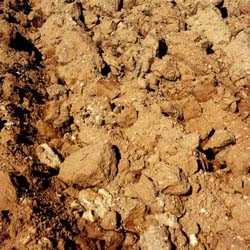Ask Mr. Sage: What Sages Grow in Clay Soils?

Dear Mr. Sage,
I live in semi-arid New Mexico. My sister, who also gardens, has an abundance of rain due to living in Georgia. Oddly enough, we both have difficulty growing Salvias due to clay soil. However, my sister has succeeded in raising Bog Sage in a shady part of her yard. We're tired of murdering Salvias in our gardens. What do you suggest?
Salvia Mourner
Dear Salvia Mourner,
Plant failures are always disappointing. Densely packed clay soils can be especially difficult for Salvias when damp, because all Salvias prefer well-drained soil (some can't live without it) to allow roots to breathe and grow. Drowning can occur even in dry climates if your region experiences periods of heavy rainfall.
However, clay is rich in nutrients. While many Salvias prefer nutrient-poor soils, there are many that love the rich life. Some do best in drier clay soils; others can handle damp clays in specific drainage situations, such as slopes. I'll offer some specific suggestions in a bit, but first it helps to consider soil amendment.
Whether you live in a damp or dry area, it's always helpful to break up clay soils with regular additions of organic matter, such as compost.
Construction of raised beds containing loamy topsoil purchased from a local nursery is one of the best solutions for giving plants a head start on healthy growth when soil conditions are difficult. Shrubby salvias that are meant to be deep-rooted eventually find their way into the clay beneath the planters even if they are lined.
You may not want to line a raised bed, if you love the way earthworms improve soil by:
- Tunneling and causing aeration
- Breaking down organic matter and
- Creating nutrient dense waste matter called castings.
So give earthworms some thought before launching a raised-bed project. Lots of methods exist for construction. Here is an overview of different techniques to help you think about whether raised beds are a good solution for your yard.
All of the zones in the following recommendations refer to USDA Cold Hardiness Zones, which concern average low winter temperatures.
Dry Climates. Here are some Salvias to grow in your semi-arid conditions and clay soil. Most prefer a bit of supplemental watering, but all tolerate drought:
- Bog Sage (Salvia uliginosa), Zones 6 to 10
- Black Sage (Salvia mellifera), Zones 8 to 11
- Cleveland Sage (Salvia Clevelandii spp.), Zones 8 to 11
- Hummingbird Sage (Salvia spathacea spp.), Zones 8 to 11
- Creeping Sage (Salvia sonomensis spp.), Zones 8 to 11.
Damp Climates. You already noted Bog Sage as being a good plant for damp, clay soils. It is extremely adaptable, which is why we also included it in our semi-arid list. While Bog Sage doesn't need high fertility soil, it doesn't mind richness. Hummingbird Sage is another choice adaptable from dry to wet conditions.
Few sages thrive in persistently damp soil. None except for Bog Sage can handle damp clay in flat situations. However, on slopes, even clay soil will drain, so that is another planting option for Salvias under these conditions.
Your sister may want to experiment, in raised beds or on slopes, with the plants in our Moisture Loving group. Most of the plants in that list also love rich soils. Here are some tough plants for your sister to try on clay slopes:
- Anise-Scented Sage (Salvia guaranitica spp.), Zones 7 to10
- Hummingbird Sage (Salvia spathacea spp.), Zones 8 to 11
- Chinese Sage (Salvia chinensis 'Nanjinga'), Zones 8 to 11
If you have more questions about how to select Salvias for your local conditions, please contact us. We're always willing to help.
Thanks for Your Question,
Mr. Sage
Ask Mr. Sage is a question-and-answer feature based on topics raised in calls and emails that Flowers by the Sea receives. To send a query, just click on the Ask Mr. Sage button on this page.

 Salvia guaranitica 'Elk Argentina Skies'
Salvia guaranitica 'Elk Argentina Skies'  Salvia clevelandii 'Winnifred Gilman'
Salvia clevelandii 'Winnifred Gilman'  Salvia mellifera
Salvia mellifera  Salvia uliginosa
Salvia uliginosa  Salvia spathacea 'Topanga'
Salvia spathacea 'Topanga'
Comments
There are no comments yet.